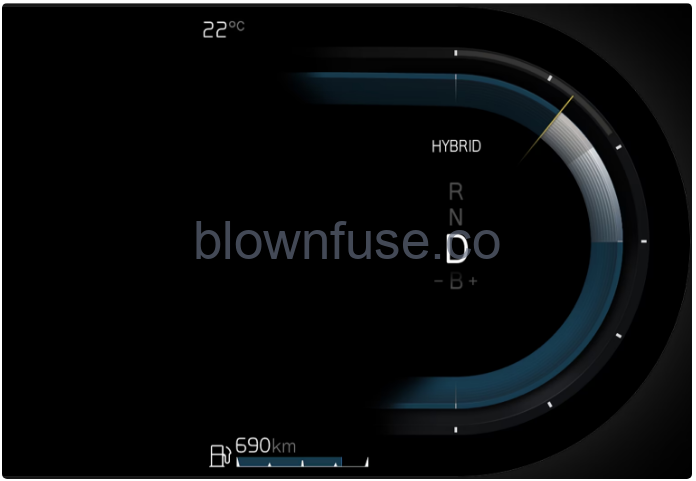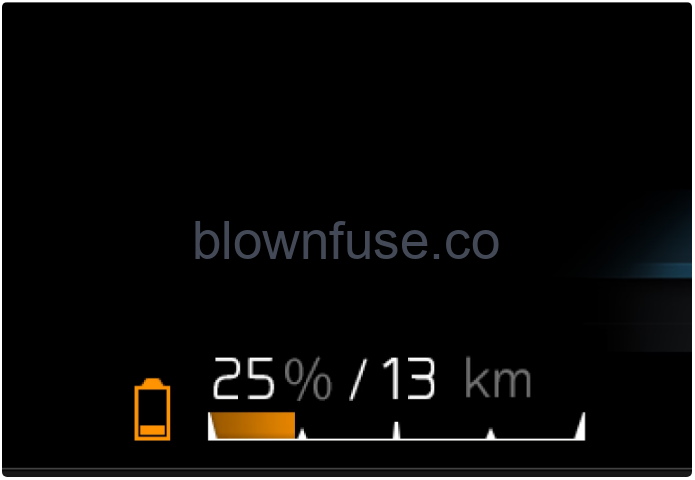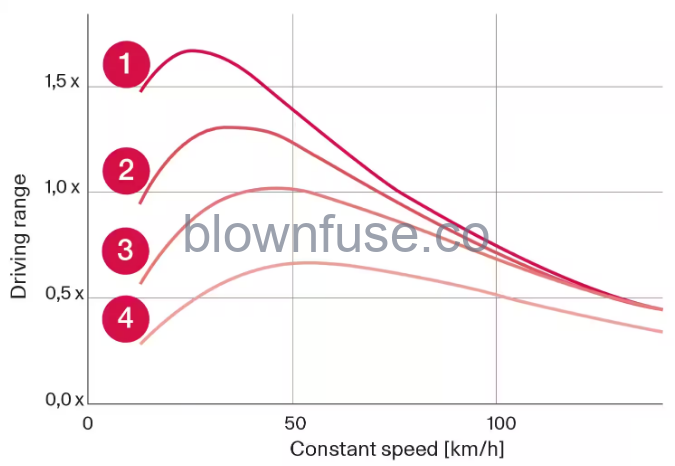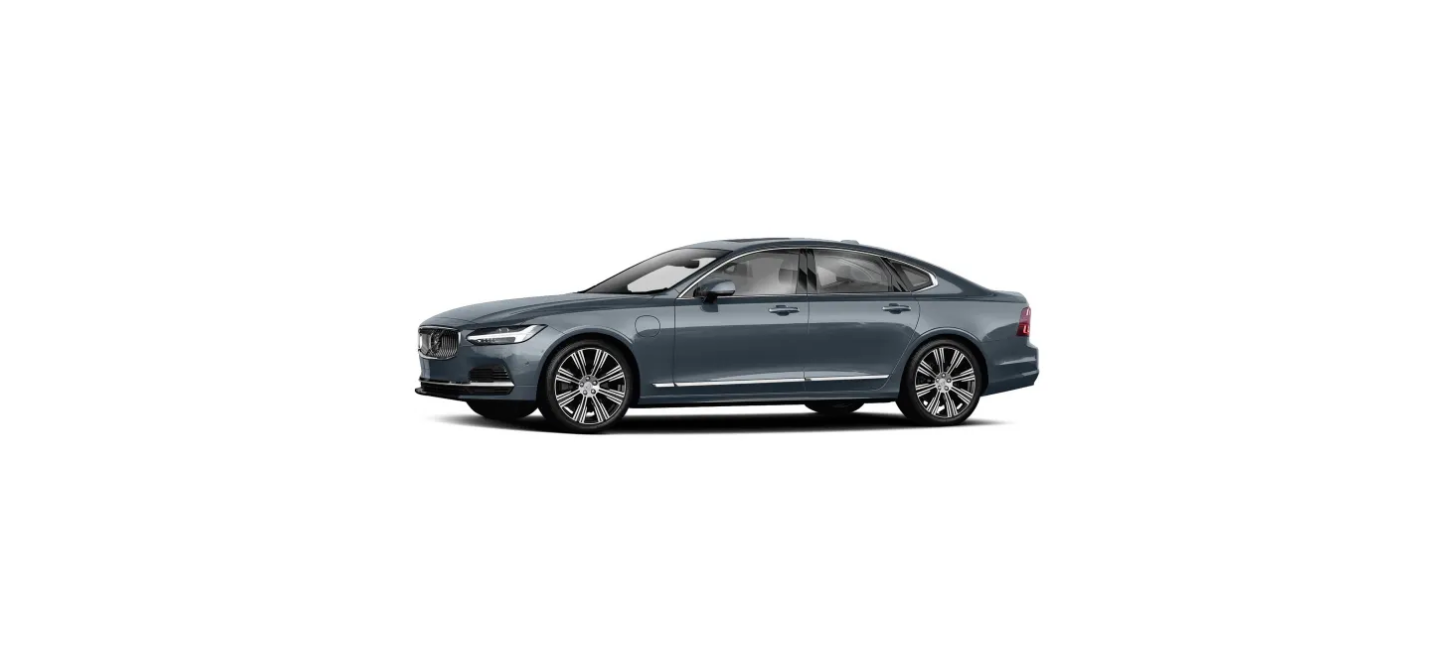2022 Volvo S90 Recharge Plug-in hybrid Drive Modes

Regenerative braking
(Option/accessory)
The car recovers kinetic energy during braking in order to reduce fuel consumption and emissions.
The function is available in all drive modes together with gear position D or B.
Depress the brake pedal.
The car brakes and regenerates energy.
Release the accelerator pedal.
The car brakes and regenerates energy.
Regeneration increases during engine braking when manual gearshift mode B is selected.
Battery usage
Control the battery’s State of Charge (SoC) while driving using Hold and Charge.
Hold and Charge are available in all drive modes. The functions are cancelled if Pure drive mode is activated.
Hold

When Hold is activated, the charge in the hybrid battery is maintained and can instead be used at a later time, e.g. when driving in city traffic.
The car works as for normal hybrid operation with the discharged battery where, in addition to reusing brake-generated energy, for example, the car starts the internal combustion engine more often in order to maintain the charge in the battery.
Charge

When Charge is activated, the hybrid battery is charged using the internal combustion engine in order to obtain increased electric drive at a later time.
Activating Hold or Charge
Activate via the centre display.
- Press
 .
. - Select Driving.
- Activate the function you require beside Battery usage.

In Hybrid drive mode, with battery usage set to Auto, smart energy distribution can be used by using Google Maps in order to drive the car as energy efficiently as possible for the whole mileage.
Creep mode
Creep mode can facilitate progress at low speed, e.g. in traffic queues or in car parks.
When the function is active the car will move slowly in the selected travel direction without the accelerator pedal being used.
Activating or deactivating creep mode
- Press
 in the centre display.
in the centre display. - Select Driving.
- Activate Creep.
- Creep mode is now activated.
Drive modes
Adapt the drive mode according to the situation the car is being driven in.
Selectable drive modes
Four drive modes can be selected: Hybrid, Pure, Power and Constant AWD.
The different drive modes are adapted to provide as good driving characteristics as possible in terms of the following:
- steering
- engine/gearbox/all-wheel drive
- brakes
- shock absorption
- driver display
- climate settings.
Indication in the driver display

The driver display indicates the drive mode selected.
Hybrid
When the car starts, it is in the Hybrid mode. The electric motor and internal combustion engine are used, individually or in parallel, and their use is adapted with regard to performance, fuel consumption and comfort. The capacity to run solely with the electric motor depends on the hybrid battery’s energy level and, for example, the need for heating or cooling in the passenger compartment.
Volvo recommends that you use the Hybrid mode for day-to-day driving.
- all-wheel drive is engaged automatically when required
- the internal combustion engine is started more often at low State of Charge (SoC) in the hybrid battery. Charge the car or activate Charge under Battery usage in the centre display to run on electricity alone.
- the car can be run on electricity alone at high State of Charge (SoC). The internal combustion engine starts when the energy level in the battery is insufficient for the engine power that the driver requests with the accelerator pedal.
- energy is regenerated back to the hybrid battery during gentle pressure on the brake pedal.
Pure
Use of the car’s electric motor is prioritised in the Pure mode. The drive mode is available when the hybrid battery has a sufficiently high charge level. If the battery’s charge level is too low, the car’s characteristics are controlled in order to provide as low energy consumption as possible.
Volvo recommends that you use the Pure mode for day-to-day driving.
- the output of some climate settings is adapted
- in slippery road conditions, slightly more wheel-spin may be permitted before all-wheel drive is engaged
The Pure mode is available when the hybrid battery has a sufficiently high State of Charge (SoC) and power output, which may be affected by temperature. When the internal combustion engine starts, the drive mode automatically changes to the Hybrid mode until the driver has the opportunity to select the Pure mode again.
The internal combustion engine starts:
- if the battery’s State of Charge (SoC) is too low
- if the driver fully depresses the accelerator pedal.
The Pure mode is not available:
- if the battery’s State of Charge (SoC) is too low
- if the speed exceeds 140 km/h (87 mph) (does not apply when driving downhill, etc.)
- in the event of system/component limitations e.g. low outside temperature.
Power
The Power drive mode adapts the combined power output from the electric motor and internal combustion engine in order to provide as high as possible performance and response to acceleration. The gear changes become faster and more distinct, and the gearbox prioritises a gear with greater traction. Steering response is faster and shock absorption harder.
Volvo recommends that you use the Power mode when you want sportier characteristics and faster response to acceleration.
- fuel consumption may increase.
Constant AWD
The Constant AWD drive mode improves the car’s traction with enhanced all-wheel drive. An adapted distribution between the front and rear axle torque provides good traction, stability and roadholding.
Volvo recommends that you use Constant AWD for slippery road conditions, when driving with a heavy trailer, or when towing.
Changing drive mode
- Select the drive mode adapted for the current driving conditions.
- Remember that not all drive modes are available in all situations.
Change the drive mode via the centre display.
- Press
 .
. - Select Driving.
- Select the required drive mode.
Distribute the electrical energy as energy-efficiently as possible for the whole mileage using Google Maps.

In the driving position Hybrid the car is powered by both the electric motor and the internal combustion engine. If a destination has been selected in Google Maps, the car calculates how the electrical energy should be distributed as energy-efficiently as possible for the whole mileage. For example, the calculation includes speed limits, traffic, and elevation differences
Using smart energy distribution
Select destination in Google Maps and check that the criteria below have been met:
- Hybrid drive mode is selected.
- Battery usage is set to Auto in the settings for Driving in the centre display.
Launch function
(Option/accessory)
Launch can be used when maximum acceleration is required from stationary. The function is available in the following drive modes: Hybrid, Constant AWD and Power.
Activate Launch
Make sure the car is stationary and the wheels are pointing straight forward.
- Move to gear position D.
- Depress the brake pedal fully.
- Then fully depress the accelerator pedal.
- Release the brake pedal within 2 seconds.
Range
The car’s range depends on several factors. The ability to achieve a long-range varies according to the circumstances and conditions under which the car is being driven.
The certified value for the car’s mileage should not be interpreted as an expected range. The certified value should primarily be used to compare different cars and is obtained during special test cycles.
Range in the driver display

The estimated range is shown in the driver display.
When the car is delivered from the factory, or after a factory reset, the range is based on the certified value. When the car has been driven for a while, the range is based on historical driving patterns.
Factors that affect the range
In addition to historical trip data, there are several different factors that affect the range. The longest range is achieved under extremely favourable conditions when all factors have a positive impact.
Examples of factors that affect the range:
- speed
- climate settings
- topography
- preconditioning
- tyres and tyre pressure
- traffic situation
- temperature and weather
- road conditions.
Range based on speed and outside temperature

- 20 °C (68 °F) outside temperature and passenger compartment climate Off.
- 20 °C (68 °F) outside temperature and passenger compartment climate On.
- 35 °C (95 °F) outside temperature and passenger compartment climate On.
- -10 °C (14 °F) outside temperature and passenger compartment climate On.
The diagram shows the approximate ratio between constant speed and range.
The graph shows that a lower speed gives a longer range. The outside temperature also affects the range, so very cold or very hot ambient temperatures result in a shorter range.
Lines 1 and 2 show the approximate difference in range affected by the climate functions. Turning off climate control is more beneficial for range.
All-wheel drive
- All-wheel drive (AWD) means that the car is driving all four wheels at the same time, which improves traction.
- The electric motor that drives the rear wheels enables electric all-wheel drive functionality. All-wheel drive characteristics vary depending on the selected drive mode.

